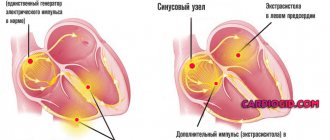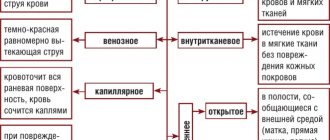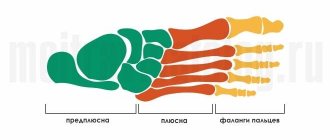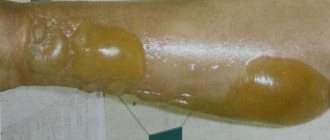Types of fractures
Often the patient asks the doctor about what types of foot fractures there are. Conventionally, all these damages are divided into the following types.
This includes disorders with and without displacement of bone remains.
This category also includes:
- Open foot fractures. A person bleeds heavily, bone remains are visible, the wound becomes easily infected, and serious illnesses develop.
- Closed foot fractures.
There are also violations:
- oblique;
- splintered;
- transverse;
- fragmentary.
Pain is caused by broken:
- Cuboid and navicular bones. The main sign of such a foot fracture is considered to be a fall of a large load on the lower limb or a collision with a car. It is difficult to identify such a disorder at an early stage, since a person’s motor activity remains at the same level.
- Heel bones, talus bones.
- Sphenoid bones.
- Bones of the tarsus, metatarsus.
- Phalanges of the lower extremities.
Fractures of the tarsal bones
These bones are also easy to break. This is facilitated by severe injury to the toes. Some patients do not even notice that their fingers are injured, so they continue to actively move and work.
Metatarsal fractures
Such bruises happen often. This is facilitated by hitting the legs with a heavy object or squeezing them strongly. Moreover, usually not one, but several bones are damaged at the same time.
Fractures with or without displacement
Displaced foot fractures are caused by lateral loading. It is she who changes the position and integrity of the bones. It will take a long time to recover from such an injury.
In addition, such violations are provoked by jumping from a great height and landing on the heels, or falling a heavy large object on the leg.
But remember: such a fall does not affect all the bones of the foot, but only some of them.
Symptoms of a metatarsal fracture
A person with a broken bone will experience the following symptoms:
- the foot and sole swell;
- limbs hurt, but usually this symptom is characteristic of bruises of 2-3 bones. A person also experiences hemorrhages and pain when palpating the painful area. If the foot is broken, the citizen cannot step on the leg or make movements with it.
Symptoms of a tarsal bone fracture
If a person is injured in this particular area, then he cannot even move his foot normally. In this case, swelling and blueness develop on the damaged fingers, and hematomas form under the nails.
How to find out that there is an offset
It is very difficult to independently determine whether a person’s foot bones are broken.
But if his foot bones are broken, he will have the following symptoms.
- strong pain;
- the foot will quickly swell;
- the position of the foot bones will be distorted.
Regardless of whether the patient has the first signs of a foot fracture or not, he should still consult a specialist. It will help you understand how to identify a specific foot fracture.
Prevention
In order to avoid injury, the load on the legs should be increased gradually. You should eat foods high in calcium. Shoes should be comfortable (ideally, these should be orthopedic shoes), physical activity should be alternated with rest. In any place you should follow the rules of personal safety and watch your step.
If an injury does occur, then immediately contacting a doctor will protect you from the development of complications and serious consequences in the form of lameness or disability.
Main symptoms and signs of foot fractures
A fracture of the foot or leg is characterized by the following symptoms.
A person usually:
- the leg takes an uncharacteristic position;
- swelling of the foot and ankle joint;
- pain in the leg, in the ligaments;
- the thumb visually appears smaller;
- the ankle turns red and hemorrhages appear;
- mobility decreases sharply;
- There is a sharp numbness, the leg begins to get cold.
The above symptoms rarely occur when a leg or limb is broken.
First aid for fractures of the foot bones
Initially, the victim must be taken to the hospital. But before this, a person with a broken foot should be given first aid.
And if relatives are wondering how to help a victim with broken foot bones, then they need:
- Limit his mobility. To do this, you can place a small pillow under the broken leg.
- Apply a cold compress. The patient's relatives can take the bag in their hands, put 2-3 pieces of ice in it, wrap it in a scarf, and apply it to the problem area. It takes 10–15 minutes to hold the compress. Next, you need to take a 5-minute break and repeat the procedure again.
- Apply a bandage, but not tight.
At the emergency room, a person with a foot fracture must have an X-ray, a diagnosis made, and appropriate treatment prescribed. Moreover, x-rays are taken in several projections. This is the only way to determine the type of damage.
In this case, the doctor examines the injured limb and identifies the mechanism of injury.
Diagnostics
First, the doctor examines the damaged area, assesses the swelling of the tissue, the extent of the hematoma, the degree of deformation of the foot, and clarifies the circumstances of the injury. Next, the doctor carefully palpates the fracture site and prescribes an X-ray examination in the direct (upper and lower) and lateral projections.
Additionally, a computed tomography may be prescribed to see the condition of the muscles, ligaments and joints. After diagnosis, the doctor prescribes therapeutic measures.
Treatment
Treatment procedures depend on the type of injury the person received.
The patient only needs to fix broken metatarsal bones. This is done with a bandage or medical shoes.
With a slight bruise, the patient only needs to reduce the load and walk using crutches or a cane.
Remember: a cast is applied to immobilize the limb. For complex bruises, he undergoes surgery.
Fractures without displacement
If the foot is fractured without displacement, the patient needs immobilization, so he is given a plaster cast. Moreover, it is applied not only to the problem area, but also to two adjacent joints, i.e., up to the middle third of the lower leg. For 1 week the patient must remain on bed rest.
Displaced fractures
In case of a displaced fracture, the doctor first puts together the broken fragments and fixes them in their final position, which should be as close as possible to the anatomical one.
Moreover, the remains of the bones are compared in several ways, and the method depends on the type of damage:
- In a closed way. This method is used if the skin at the site of injury is not broken. With this comparison, the surgeon and his assistant move the bone fragments apart until a large gap forms between them. Next, the bone fragments are brought together and fixed with a plaster cast. But this method also has one drawback. Sometimes the remnants of bones are not fused correctly.
- In an open way. The patient undergoes surgery. Surgery is performed if several bones are injured or the patient has fragments. In this case, the patient has needles, screws, and plates inserted into the damaged limb. They securely fix the fragments. This method also has some disadvantages. The patient may develop an infection, osteomyelitis. But antiseptics and aseptics help get rid of these shortcomings.
Open lesions are very difficult to treat.
The patient must undergo antibacterial therapy. It reduces the risk of pus appearing in the wound and infection. And then the doctor will be able to answer the patient’s question about how long it will take for a fracture of the foot to heal, and whether it will be able to heal at all.
Duration of treatment
In general, the treatment period for a foot fracture lasts from 3 to 12 weeks . But, if a patient asks how long it takes for a foot fracture to heal and heal, then a specialist will help answer it.
Forecast
Trauma to the foot has a good prognosis. Usually, after 4–5 weeks, the ability to work is completely restored, the person returns to his normal life, and there is no trace of pain in the leg.
The speed of regeneration depends on the conditions in which the patient is: his environment, daily routine, nutrition and rest, compliance with doctor’s instructions. If there are no concomitant diseases that complicate the prognosis, then there is nothing to worry about - rest and minimal stress on the affected area will do the trick.
But to prevent recurrent fractures, it is worth taking care of the comfort of your feet for at least a period of 10 months. To do this, you need to wear comfortable shoes and buy orthopedic insoles if desired.
Remember that preventing a disease is much easier than curing it. Watch your menu and be careful when crossing the road or playing sports.
When can a plaster cast be removed?
The period of immobilization of a person depends on the type of illness.
If he has:
- isolated fracture of the hind process of the foot, then immobilization lasts 1.5 months;
- the metatarsal bones are damaged, then immobilization lasts 1.5 months;
- If the tarsal bones are damaged, immobilization lasts 1 month. But with severe displacement, immobilization lasts 6 months;
- the neck or body of the talus is damaged, then a cast is worn for 3 months;
- If the phalanges of the fingers are damaged, a cast is worn for 6 weeks.
And if a person is wondering how long to walk in a cast with a wedge-shaped fracture of the bones of the foot, then it is better for him to ask a doctor this question.
If the patient follows all the doctor’s recommendations, then his foot will heal quickly and he does not need to wonder how long to wear a cast for a non-displaced foot fracture.
Broken toes: how does the damage manifest?
If any weight has fallen on the foot or a severe bruise has occurred, then the appearance of broken phalanges of the toes is possible. It is easy to notice such an injury, since the injured finger immediately becomes cyanotic and completely loses sensitivity. It is important to practice fusion of the bones of the phalanges of the fingers under the supervision of a doctor, since the fingers have a strong impact on a person’s balance and motor function. If the phalanges are not fused correctly, the victim may have problems with movement.
Rehabilitation period
Activity in the limb is restored quickly. The main thing is to follow the following recommendations.
The patient must:
- Take your time to take a vertical position. This rule applies to those patients who will be immobilized for 6 weeks. After immobilization, a person with a foot fracture should walk with crutches for 2 weeks. But if he was immobilized for a short time, then he can begin physical activity immediately after the doctor’s permission.
- Keep lower limbs in warm water. You can add medicinal herbs and sea salt to it. Such baths strengthen the bones and have a slight calming effect.
- Visit a specialized massage therapist.
- Switch to proper nutrition. It is food that makes bones hard. It is better to give preference to foods that are rich in vitamins and calcium.
- Walk a little. But after getting rid of the plaster cast, you can’t move much right away. A doctor should tell you how long you should not step on your feet. The patient can only take short walks 3 times a day. Gradually the distance can be increased.
- Use orthopedic insoles. They prevent bone divergence and flat feet.
- Give preference to shoes recommended by an orthopedist. It is worn for 6 months.
It will take 3–4 weeks to fully restore activity.
If complications occur, the recovery period is delayed by 2–3 months . A fracture of the bones of the arch of the foot is considered serious by doctors. You should switch to active sports after 4 months.
Physiotherapy
It helps reduce the patient's recovery period.
Why is it used?
It's simple. She:
- helps with many ailments;
- appointed by people of different age categories;
- does not provoke the development of an allergic reaction or addiction;
- has a mild effect;
- rarely causes serious illness.
Medical procedures are used to help warm the problem area from the inside.
Initially, the patient is prescribed:
- UHF. The procedure is done on day 2. The session lasts 15 minutes. The electromagnetic field helps to dilate blood vessels, increases blood flow to the problem area, eliminates pain and swelling.
- Magnetotherapy. Such procedures help improve metabolic processes and help restore the integrity of the bones. 10–15 sessions are done.
- Electrophoresis. Such procedures perfectly eliminate pain. During the session, the specialist attaches electromagnetic plates over the problem area. But be sure to pre-moisten the plates in novocaine. This way the drug will better penetrate the damaged area and eliminate pain. You need to do 15 sessions of 15 to 20 minutes.
- Interference currents. They help get rid of unpleasant symptoms. Currents also create rhythmic microimpulses that increase blood flow and neutralize stagnation.
- Sollux lamp. During the procedure, the device emits infrared light. It has a positive effect on the entire body. This device perfectly warms up the tissues, speeds up their metabolism and blood circulation. After this procedure, swelling and bruising disappear.
Exercise therapy after a fracture
Therapeutic and gymnastic exercises also help to reduce the recovery period of a person with a fracture of the bones of the foot and other small bones. They also strengthen muscles and tone them. Initially, it is advisable to perform the treatment complex under the supervision of a specialist. The load should be minimal. Gradually the load can be increased. But a specialist should also say this. This is the only way the patient will not harm himself.
The patient can do the following exercises.
He must:
- Lie on your back or sit down, bend your knees, bend and straighten your fingers. At first, the movements should be active and then passive, that is, bending should be done using the fingers or fingers of the massage therapist. You need to do 10–15 movements.
- Take the same starting position. Now he needs to do dorsiflexion and plantar flexion of the foot. You need to do 10 movements.
- Lie on your back or sit down with one leg crossed over the other. Now he needs to perform circular movements in a bent joint. You need to do 10–12 movements.
- Lie on your back and dorsiflex your foot. Movements can be gradually increased. You can help yourself with a braid with a loop. The movements must be done 10 times.
- Take the same starting position, bend your knees, try to grab objects with your fingers. You need to do 10–12 movements.
- Take the same starting position, turn your foot inward and outward. You need to make 10–15 movements in each direction.
- Lie on your back, place your toes one on top of the other, dorsiflex and plantar flex the foot. You definitely need to resist. Moreover, the movements are made with one leg, and you need to resist with the second leg. You need to do 10–12 movements.
- Lie on your back, sit down, bend your legs, and grab the ball with your feet. You need to do 10–15 movements.
- Sit or stand and roll a medicine ball with the tips of your toes. You need to do 10–12 movements.
- Sit down, place the sore leg on the gurney, perform active flexions with the healthy leg and passive flexions with the problematic limb. You need to do 15 movements.
- Lie on your back, sit down, place your foot on the pedal apparatus, bend your feet with resistance. 10–12 movements are made.
- Take the same starting position and try to hit a small ball with the tips of your sore leg. You need to do 10–15 movements.
- Sit down, stand up, put your hands on the gymnastic wall, turn your toes inward, slightly raise the inner arch of the foot, but the weight of the body must be transferred to the outer side of the foot. 12–15 movements are made.
- Stand on the 2-3 step of the gymnastic apparatus, grab the step located at chest level, lightly spring on your toes, and lower your heel lower. You need to do 12–15 movements.
- Stand next to the gymnastic apparatus and knead the first step with your feet. You need to do 15–20 movements.
These exercises can be done for any bruise of the lower extremities, but only after consultation with a specialist.
Foot massage after a fracture
During recovery, massage is very important.
He:
- helps warm up atrophied muscles and tissues, strengthen blood vessels;
- tones muscles, makes them more elastic;
- restores mobility in the damaged area;
- eliminates stagnation;
- increases overall limb mobility.
To summarize: preventing injuries to the lower extremities is simple. The main thing is to maintain safety when engaging in this or that activity. There is no point in risking your life and your health. The price to pay for such a risk can be very high.
Causes
Fractures occur when exposed to an external mechanical force that exceeds the elastic force of the bone. This can occur due to a high intensity of force (traumatic fracture) or when the strength of the bone tissue decreases (pathological fracture). When exposed to prolonged traumatic stress of moderate intensity, so-called stress fractures occur. An example of such damage is a “marching fracture” in recruits.
A traumatic fracture can be caused by:
- Direct hit.
- Falling or jumping from a height.
- Excessive rotation of the foot.
- Excessive dorsiflexion.
Structure of the human foot
Pathological fractures occur with the following diseases:
What does an MRI of the foot show?
- Osteoporosis. Bones become brittle as a result of a lack of calcium and magnesium.
- Genetic abnormalities. There are congenital pathologies in which the process of bone mineralization is disrupted. As a rule, with genetic abnormalities, fractures are multiple.
- Bone tumors. Neoplastic processes cause thinning of bones, and fractures can occur even with minimal stress.
- Osteomyelitis. Bone fragility in osteomyelitis is caused by a severe infectious process.
- Impaired bone mineralization when taking medications (steroid hormones, anticonvulsants, tetracycline antibiotics, thyroid hormone preparations, cytostatics).











